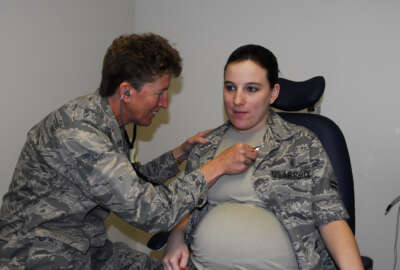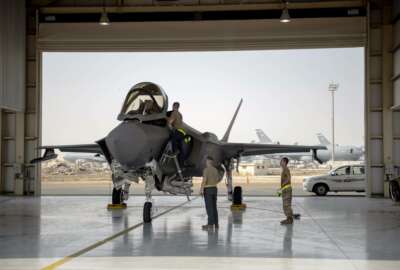
Air Force flyers might be young, but they’ve eventually got to heed the call of nature
Ever been on a long airplane flight and, after all that coffee or tea, you really gotta go? Imagine being on a long flight in a cramped cockpit and there's no aisle...
Best listening experience is on Chrome, Firefox or Safari. Subscribe to Federal Drive’s daily audio interviews on Apple Podcasts or PodcastOne.
Ever been on a long airplane flight and, after all that coffee or tea, you really gotta go? Imagine being on a long flight in a cramped cockpit and there’s no aisle to line up in, no restroom. That’s a daily reality for the Air Force. Solutions have been so sub-optimal, that the service says airmen routinely dehydrate themselves so they can make it through flights. Now the Air Force has deployed what it calls an improved in-flight bladder relief device. Air crew flight equipment program analyst Scott Cota joined the Federal Drive with Tom Temin for details.
Interview transcript:
Tom Temin: Mr. Cota, good to have you on.
Scott Cota: Thank you.
Tom Temin: So to begin with, we’re talking about fighter aircraft. I’m presuming the transports have restrooms like airliners?
Scott Cota: Yes, absolutely. Yep. This is for fighter aircraft specifically.
Tom Temin: And for fighter crews. How long can flights last from takeoff to when they land again?
Scott Cota: Well, for this particular device, I mean, obviously, it can change a lot with depending on what their mission set is. But we targeted around a six to eight hour flight time.
Tom Temin: Yeah, that’s a long time even for somebody under 30, I guess, if they’ve had coffee beforehand. So what has been the solution until now that causes the airmen, and airwomen I suppose too, to simply try to not have the need to before they take off.
Scott Cota: For this particular device, we’ve been focusing more on the female fighter air crew. The device that they’ve had in the past is a version of this device that we’ve worked. It’s just it wasn’t designed for the amount of female aircrew with the different ranges and anthropometrics and that we’re trying to achieve right now.
Tom Temin: One size does not fit all,
Scott Cota: Yea, one size does not fit all.
Tom Temin: How does it work? I mean, what’s the general with, you know, without being overly explicit, what is the apparatus designed to do specifically?
Scott Cota: It’s pretty much got three main components: You’ve got the relief bag, there’s a pump, and then there’s what we’re calling the human interface, and then there’s hoses that connects it together. And the real challenging part of this device is, of course, the human interface part, where you start getting into where we’ve got the different ranges and different sizes of people. And we knew that what we had to have was different sizes, and that what we’ve had just wasn’t work. They were getting leads and those kinds of things. So then it was still forcing them back into that tactical dehydration, where they could get potential for kidney stones and urinary tract infections and those sorts of things.
Tom Temin: And also dehydration while you’re in flight could cause problems with cognition and so forth, correct?
Scott Cota: Yes, it can. Absolutely yeah. Reduce G performance in those areas that you mentioned.
Tom Temin: And the other interface I’m curious about is the uniform interface, because somehow it has to get from inside to outside. So that must have been a challenge also.
Scott Cota: Yeah, because what ends up happening is the human interface with female anatomy, they’re basically sitting on it for that entire duration of the sortie — so six to eight hours. So it has to be something that’s comfortable, but also effective. And you’ve got to make sure that it’s something that’s comfortable, that it’s effective, and that it also has minimal leaks, because obviously you don’t want to be there six to eight hours with leaks.
Tom Temin: Alright, and so you turn to a contractor, and what type of program did you design for a company to come up with something? Did you design specific specifications with shapes and dimensions? Or did you just say, here’s the problem, what can you do about it?
Scott Cota: Yeah, I mean, and that’s what I do. I do the requirements part. So that’s what I came up with was, here’s our problem. Now we have a program office out at the Air Force Lifecycle Management Center, but they actually manage the overall program. But this is just the first of we’re actually looking at a suite of options. Because we know that, you know, as I’ve mentioned, that one interface isn’t going to work for everybody. But for this particular one, it’s a vendor that they’ve already worked with, we’ve already got a device from them. So we knew that we could probably make some improvements and get something out there relatively quickly while we work the more long term and go out to industry in generate completely new products.
Tom Temin: We’re speaking with Scott Cota. He’s an aircrew flight equipment program analyst with the Air Force. And the vendor, do they simply supply military with these kinds of devices, or is there a commercial counterpart to this class of product?
Scott Cota: I’m not 100% sure, but I believe the company is also branched out into medical areas where folks that are bedridden.
Tom Temin: I imagine there must be female crane operators because sometimes those are long shifts way up in the air, and it takes a half an hour to get down. Or maybe truck drivers.
Scott Cota: I’m not sure if all the areas they branched out into. I know they’ve tried but we are one of the primary customers, because the device that we’re after, there’s more specific requirements where, you know, if you’ve been in a cockpit, it’s pretty tight, pretty confined. And then because it’s an ejection seat, they’re supposed to maintain and be strapped into it at all times and not unbuckle. So it’s a little more challenge. And then of course, because it’s something that’s going in a cockpit, it’s got to meet all of the safety requirements, you know, to be allowed in there.
Tom Temin: Right. Plus, you have the issues of pressure. And I imagine maybe even temperature and vibration.
Scott Cota: And those are all tests that that they ran this device through.
Tom Temin: Did they deliver a prototype for a test phase? And do you test it in the air? Or do you test it maybe on the ground for eight hours before you have it fly?
Scott Cota: Yeah, what we did was we broke it up into two phases. We have a separate test organization that they did some ground tests. And what they actually did was they went out to the company, and the company actually had some ejection seats there, and we sent air crew out there to sit into the seats, to use it to get comfortable. And then we had a phase where the company was right there with their designers and their engineers. And they would be able to sit there and you know, use it for a few hours, and then give immediate feedback to the company and let them know, hey, we’re still uncomfortable here — I’ve got a hotspot, you know, I have leaks — and then they were able to address it. And they were able to make some changes on the fly, so to speak, over the next couple of weeks. So it was sort of an iterative process over a month, where we got to the more of the final design or the interface. And then they did some separate flight test.
Tom Temin: And so there’s really no way of getting the feedback for the efficacy results, other than having actual air staff use it in either a controlled environment or later on up in an airplane.
Scott Cota: Absolutely, we make sure that everything gets flight tested. We have to have the pilots use it and get that direct feedback from them, to make sure that it’s going to work and do what it needs to do for them.
Tom Temin: And you mentioned, of course, cockpits don’t have a lot of room in them. And there’s an external component to this — the bag and the pump and so forth are outside of the flight suit. And what about the fact that the Air Force operates many, many types of fighters, some even two person, two cockpit, or one cockpit. And so you had to ensure that it fits in all of them, correct?
Scott Cota: Yes, absolutely. Yep, our tester did the flight test. And she actually went out to different units F16, F15 units, then I think they even went out to a bomber unit as well to a B52 unit to where we had the female pilots out in the units so that they could get the numbers and get the data that they needed.
Tom Temin: These were deployed in December — what have the results been so far from the air?
Scott Cota: Actually just did our first shipment because the first set of devices arrived. We had 50 arrive right before the holidays. We didn’t ship any out right before then. But I think our first shipment out to a unit that’s asking form is going out this week. So we haven’t been able to get any more feedback than we’ve got from the testing yet. They’re gonna deliver us 50 systems a month. 250 Total is what we’re getting, 50 a month.
Tom Temin: Before the test pilot takes up the device to test, do they have like a double large 7-Eleven coffee?
Scott Cota: No, what they were doing during the testing, at specifically during the ground testing, was have them drink water to try to keep them normally hydrated that they would for a sortie, or when they go fly.
Tom Temin: And just a detail point — if, God forbid, someone has to pull the ejector seat, and those are pretty violent injections, does the whole bag and apparatus go with it?
Scott Cota: It actually will break away at the hose so that none of it will go with them.
Tom Temin: And while we have you, what about the male pilots? Are they pretty well taken care of with existing equipment?
Scott Cota: Right now we’re focused on, because of the challenge with trying to meet, you know, in particular the health and safety of the female aircrew. But we’re going to go back after we get the more challenging part that we’re working now, and go back and see if there is any interest from male pilots. I mean, they’ve got the old peddle packs that have been around for probably since they started flying fighter aircraft. But we’re gonna go out and see if this is a device or something that they may be interested in.
Tom Temin: I guess in the old days of fighters in World War I, you could get away with maybe a small galvanized bucket because the planes were slow, but not nowadays, huh?
Scott Cota: Correct.
Tom Temin: Scott Cota is an aircrew flight equipment program analyst at the Air Force. Thanks so much for joining me.
Scott Cota: Yeah, no problem. Thank you for having me.
Copyright © 2025 Federal News Network. All rights reserved. This website is not intended for users located within the European Economic Area.
Tom Temin is host of the Federal Drive and has been providing insight on federal technology and management issues for more than 30 years.
Follow @tteminWFED
Related Stories





